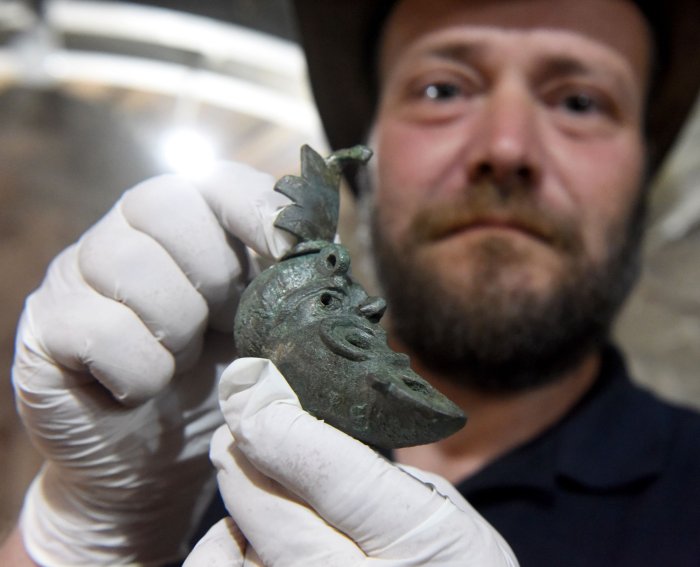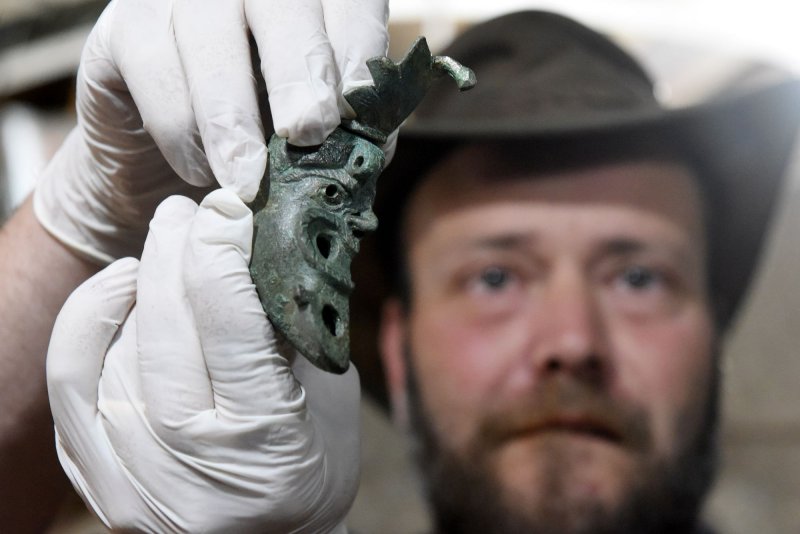
A one-of-its-kind flower species in Greece mimics the smell of rotting insects to attract and trap flies in order use their pollination services. Photo by T. Rupp, B. Oelschlägel, K. Rabitsch et al.\
May 21 (UPI) -- Scientists have uncovered the deceptive pollination tactics of a first-of-its-kind flower that mimics the scent of decaying insects to attract and entrap so-called coffin flies.
Flies from the genus Megaselia don't like to eat rotting flesh -- instead, they mate atop and lay their eggs inside decaying insect corpses.
Over millions of years, the flower Aristolochia microstoma -- described Friday in the journal Frontiers in Ecology and Evolution -- evolved foul-smelling flowers.
The novel flower isn't carnivorous, though. Rather, it traps flies to utilize their pollination services.
RELATED Amber fossil proves Cretaceous beetle ate pollen of flowering plants
Once trapped inside the putrid scented petals, the coffin flies pollinate the female organs before being coated in pollen by the male organs.
"Here we show that the flowers of A. microstoma emit an unusual mix of volatiles that includes alkylpyrazines, which are otherwise rarely produced by flowering plants," co-author Stefan Dötterl said in press release.
"Our results suggest that this is the first known case of a flower that tricks pollinators by smelling like dead and rotting insects rather than vertebrate carrion," said Dötterl, professor and head of the plant ecology group at the Paris Lodron University of Salzburg in Austria.
RELATED Insect diversity boosts longterm stability of crop pollination services
A small minority of plants -- 4 to 6 percent -- are pollinated under false pretenses, using appearance or scent to advertise an absent award to pollinators.
Many orchids use deceptive pollination, as do many members of the genus Aristolochia.
"Aristolochia contains over 550 species around the world, especially in the tropics and subtropics," study co-author Christoph Neinhuis said in the release.
RELATED Full-bellied fossil suggests flies were active pollinators 47 million years ago
"They are mostly woody vines and herbaceous perennials with striking, complex flowers that temporarily imprison their visitors to get pollinated," said Neinhuis, a professor and cultivator of one of the largest Aristolochia collections in the world at Dresden University of Technology's Botanical Garden.
Small hairs inside the petals of Aristolochia flowers guide trapped insects toward the sexual organs. On their way down, pollen from the insect is deposited onto the female organs.
The presence of the trapped insect causes the stamen to ripen and release pollen to be carried elsewhere. After pollination, the hairs whither and the insect can escape.
To lure flies and other insects, Aristolochia give off the scent of rotting carrion and other fetid fragrances. But while the petals of Aristolochia flowers are often big and showy, A. microstoma, which is native to Greece, boasts small, brown flowers.
For the study, scientists collected 240 arthropods that became trapped inside the petals of the unusual Greek flower.
Researchers found flies from four families, as well as centipedes and springtails. Many of the captured flies were species known to frequent foul-smelling flowers.
Using gas chromatography with mass spectrometry, researchers analyzed the compounds A. microstoma uses to emit such a pungent smell.
Scientists identified 16 compounds, including several nitrogen- and sulfur-bearing volatile molecules. Several of the compounds featured oligosulfides, a molecule commonly used by Aristolochia flowers to replicate the smell of rancid meat.
Researchers also identified the presence of 2,5-dimethylpyrazine, which conjures the scent of rice or roasted peanuts.
The molecule, which is known to emanate from decomposing beetles and rodent urine, is rare among flower fragrances.
"Earlier studies had suggested that A. microstoma might be pollinated by leaf litter-dwelling insects such as ants, because of the orientation and position of the flowers," said Dötterl.
"But here we show that this isn't correct: instead, the main pollinators are Megaselia coffin flies. As their name suggests, these flies feed on carrion, on which they lay their eggs and which serves as food for the larvae, which is why they are often used as evidence in forensic medicine," he said.


















